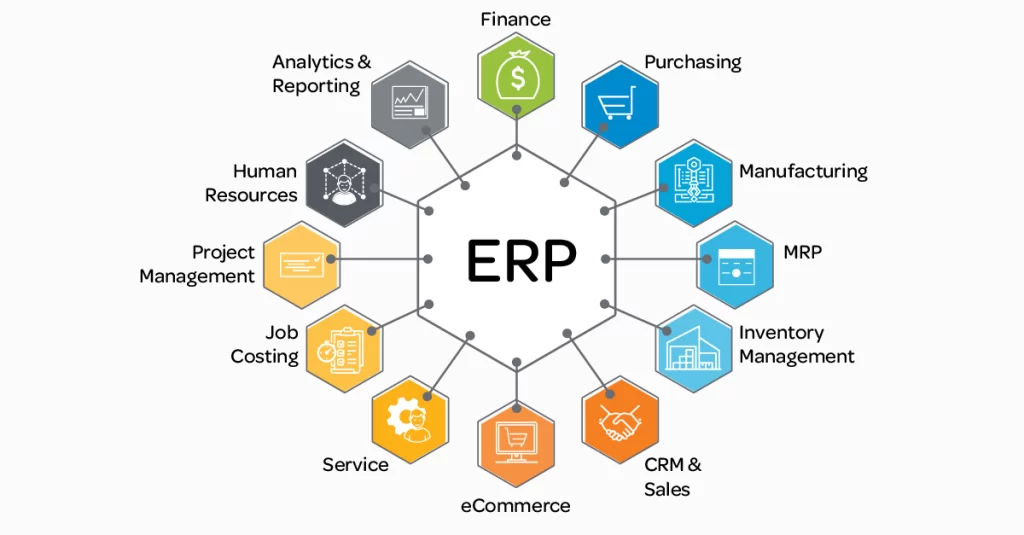There’s nothing wrong with saying that the “cloud” is the future of ERP Plus. But this was always going to happen. What’s important is to think about what skills are needed to give a business the flexibility it needs. Businesses need to be able to provide goods and services instantly, come up with new ideas that disrupt the market, and be able to lead through complicated situations.
Unfortunately, the core systems and processes of most organizations make it harder to be agile. One of the main reasons for this, even though ERP is the operational backbone, is that the data and processes are stuck in separate, siloed systems. This makes the processes inefficient, which leads to incomplete or old information. Business processes should be able to move faster from start to finish. These problems show up as incomplete data, which makes it hard to get to the transactions that are going on. This makes it hard to figure out “why” something happened and “what” might happen next.
When we think about the upcoming generation of businesses that use ERP plus systems, we will observe a change from business process chains that are driven by events to business process chains that are driven by intelligence. This transformation is based on the advancement of sensors, the amount of data that is available in near real-time, and the fact that API-driven microservices are everywhere and can be integrated with Core ERP systems.
This will make a big difference in how the enterprise works, especially in how each employee makes smart choices and then moves faster by using automation and workflows. The most important thing is to know not only what happened, but also what is likely to occur. So, intelligence will be a part of every interaction, every choice, and every process. Businesses will become much more driven by data and intelligence.

For businesses to be agile, they need a “system of intelligence” on top of their SaaS-based ERP that can watch, sense, and process both structured and unstructured data in real time and at regular intervals. Take the phrase “Improving the customer experience” as an example. In this case, “customer data” refers to how the customer has been treated. “Customer” is an entity with relationships to order, price, provider, product, reliability, schedule, service engineer, and salesperson. Every time a customer interacts with something that affects the experience.
“Many-to-many” relationships are what are used to describe how these connections are made across one or more applications. Some are in the ERP, while others are in other systems. So, if one of the most important business goals is to improve the customer experience, it’s important to make knowledge models of everything that has to do with the customer experience. In the same way, there can be knowledge graphs for employees, for products or services, and so on.
Based on this trend, of next generation of ERP Plus systems will likely be a combination of ERP SaaS (best of breed) and PaaS (as a system of intelligence), which will give businesses not only a strong operational backbone but also the flexibility they need today.
“The cost of control obviously should not exceed the cost of inaccuracies.” ERP: Making It Happen -Thomas Wallace & Michael Kremzar.
System Of Intelligence (Paas) – Value to the system:
- A system of intelligence works in real-time and is used in every interaction.
- Be able to use the data and get the process to work. Ability to get insights and set up workflows so that the process can be done automatically.
- Ability to use solutions on a pay-as-you-go model or a pricing model based on subscriptions
- Easy to configure, integrate, and move thanks to a set of pre-built API adapters and connect directly to tool sets based on an open architecture.
- It’s cheap, easy to use, and can be set up quickly as a “system of intelligence” without interfering with the ERP (system of records). The ERP systems that run the business can be “best of the breed.” So, if there are changes to the SaaS ERP platform, there are few or no changes to the PaaS platform, and vice versa.
- Able to get a new approach to business up and running quickly.
Features of PaaS:
- Creating a memorable experience by connecting entities with as little friction as possible is one of the most important criteria for deciding what goes on in the PaaS (system of intelligence).
1)Create the flow of a transaction so that the user doesn’t have to worry about which applications are involved.
2) Use data to get insights and intelligence.
3) Be able to constantly observe and learn.
4) Let you launch new products or services quickly.
5) Business “use cases” that are specific to an industry and written as services
- Let the model be based on subscriptions. Lower up-front costs by making it possible for solutions (as services) on this platform to be accessed from a cloud infrastructure that serves more than one customer. Open Architecture was used.
- Regular patch updates, including security patches that must be installed, keep the platform up-to-date. DevSecOps is used to make sure that new releases are fast and secure. This lets development teams deliver better, more secure code faster, which makes it cheaper.
- Make it easy to use. Being able to deploy faster as a “system of intelligence” without affecting the ERP (system of records).
- The platform must be strong and safe. Designed so that the system of intelligence stack is the same for all clients in a certain industry, but the system of interaction is unique to each client.
Future of ERP Plus Systems:
As the ERP constantly changes, we can anticipate the following:
A. ERP Plus product vendors will offer the full stack functionality of “system of intelligence” as PaaS, which is an “add-on” product to their existing SaaS ERP products.
B) The creation of a new category of ERP Plus products on the market by enterprise providers like system integrators or a new set of services that focus on building PaaS as a “system of intelligence” and selling the services on a subscription basis.
(c) New genre of PaaS by hyper-scale or ERP product distributors that enables all the core technology capabilities, such as telemetry, digital brain, IDE for low coding, and APIs. This makes the platform a strong marketplace for ISVs to build applications and offer a “system of intelligence” as a service. So, ISVs can make the “system of intelligence” available as PaaS solutions.
One thing is clear: Because businesses need to move quickly, the enterprise companies who decide to invest quickly to build a strong, scalable, and cutting-edge “system of intelligence” as Platform as a Service are most likely to steer the enterprise market into the future.





